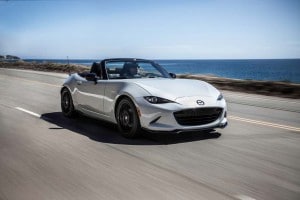
When the new iA comes to Scion showrooms later this year, it will mark the first time Toyota’s youth-oriented brand has offered a sedan.
To bring it to market, Scion sought out some help, largely repurposing a 4-door model developed by smaller Japanese automaker Mazda. Toyota also will use the subcompact Mazda2 as the starting point for the next version of its small Yaris model – which will be assembled at a new Mazda plant in Mexico.

Confused? You’re not alone. It takes more than just a scorecard to keep up with the convoluted alliances in today’s increasingly competitive auto industry. Hoping to add more models to their line-ups while at the same time driving down costs, traditional competitors are finding advantages to working together.
“No matter what the price point of a vehicle today you have to order an extraordinarily broad suite of infotainment and safety features. And you have to come up with new powertrains and lightweight materials to meet new fuel economy regulations,” explains analyst Joe Phillippi, of AutoTrends Consulting. “That’s expensive and you have to find a partner, especially if you’re working on an inexpensive vehicle.”
(Toyota reportedly planning radical 3-seat sports car. Click Here to find out more.)

But the trend isn’t limited to the bottom end of the market. Are you sure that new C-Class you just bought is really a Mercedes-Benz? And if you’re considering the new QX30 crossover, will you really be buying an Infiniti.
Both models are directly impacted by an expanding alliance between Mercedes’ parent Daimler AG, French maker Renault and Infiniti’s parent Nissan Motor Co. The latest C-Class can be ordered with a new engine produced by Nissan. Meanwhile, Infiniti is preparing to launch several models that will ride on platforms developed by Mercedes. And, in a couple of years, Mercedes and Infiniti plan to jointly produce a variety of models at a new plant in Aguascalientes, Mexico.
Automotive alliances can create some strange bedfellows. Just this past week, Toyota announced it was forming a broader partnership with Mazda. But the little maker also has a relationship with the Italian side of trans-Atlantic automaker Fiat Chrysler Automobiles.
That venture helped Mazda come up with the cash it needed to develop the next-generation MX-5 Miata sports car it will start shipping to dealers next month. In turn, Fiat will get a small roadster of its own.
(Lamborghini gives green light to Urus SUV…could turn to Audi, Bentley for help. Click Here for the story.)
There are a number of levels at which automakers are working together:
- At the most basic level, manufacturers share costs and knowledge on basic research – often for advanced powertrains and materials. Toyota and Ford, for example, are working together on fuel-cell technology;
- Manufacturers may also cooperate on the development of parts and components. General Motors and Ford are jointly developing a new, fuel-saving 10-speed automatic transmission;
- As with Daimler, Renault and Nissan, many makers are sharing the costs – which can run to $1 billion or more – of developing new vehicle “architectures,” or platforms

And, in some cases, they may share the same basic vehicle. Toyota not only will rebadge the Mazda2 as a Scion iA but is also selling the Scion FR-S which it jointly developed with Subaru.
The FR-S is virtually identical to the Subaru BRZ. But that’s relatively rare. Most alliance partners take great pains to come up with different sheet metal, notes analyst Phillippi, to avoid accusations of “badge-engineering.”
(Chevy to add Apple CarPlay and Android Auto to 14 models for 2016. Click Here for more.)
The design of “our car was untouched” by Fiat during the development of their two new roadsters, said Mazda Miata development engineer Dave Coleman. In turn, the Mazda team still has no idea what the final design of the Fiat model will look like.
Even so, by sharing the basic development work both makers were able to bring to market products they might not have been able to afford otherwise. The same is true for other manufacturers who say that by occasionally teaming up with erstwhile competitors they can add more products that deliver better mileage and offer more new features.
(A version of this story first appeared on NBCNews.com.)








The more things change….global intercorporate badge engineering
This should result in even more safety defect recalls.